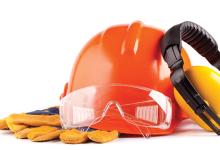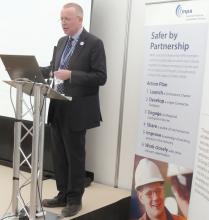Good housekeeping at a quarry site will greatly reduce the risk of accidents.
Maintaining a tidy working environment is a major step towards reducing or eliminating accidents in the workplace.
Incidents such as slips, trips and falls can be eliminated with a good housekeeping procedure. This will include identifying and then tackling the relevant issues to prevent such incidents.
Many quarry companies already do this as a matter of course, drawing up a housekeeping checklist following a risk assessment.
Such a list can be amended for a particular site or as any further problems become known.
“Maintaining a safe working environment in the quarry or aggregate industry is critical,” says
“Inadequate walkways or scaffolding, poor housekeeping and/or lack of training often cause frequent injuries. Even when careful, it is easy to slip and fall causing a muscle strain or back injury.”
The company has created a variety of industry specific safety awareness materials including the Slips and Falls video, and it designed the series of Safety Basics videos to help operators and employees understand proper safety procedures.
“They include wearing the appropriate personal protective equipment such as hard hats, footwear and hand protection,” says Caterpillar.
Late last year at the UK
She noted: “Improvement in health and safety is most effectively achieved when it becomes totally integrated into everything else you do. Those who try to do health and safety as an add-on very rarely achieve an effective safety culture that can be sustained.
“So keep doing ‘health and safety’ as an integral part of your work, make it part of being competitive, optimising production and achieving manufacturing excellence.”
There are a variety of documents and advice on how to achieve this, and many say that the operator must ensure that no work is carried out at the quarry unless a health and safety document has been prepared to demonstrate that risks have been assessed and control measures identified, put in place, followed and reviewed.
The UK’s HSE recommends drawing up a health and safety document that identifies the risks, identifies suitable control measures, enables operators to put the control measures in place, and review the document to ensure that the control measures are practical and work properly in the workplace, or modify them as necessary.
It says that it has to satisfy certain criteria. For example, the quarry may not be worked without it; it has to be understood by anyone who reads it; the relevant parts have to be given to those with responsibilities in it; it has to be readily accessible to all quarry employees; it has to comprehensively identify risks and control measures used; it has to set out the structure, duties, competencies and authority of the management, and it has to set out how and when the control measures will be reviewed.
Making sure that operations are clean, in good order and dry with safe access that is clear of spilled material, refuse, protrusions, apparatus or holes will help prevent slips, trips, and falls.
According to one expert, employees should be educated that it is necessary to pick up a broom or shovel and clean up a mess that might be in the way, with this making more sense when they know why. And this can include reminding them, as an industry, how many people have been injured because of such a mess. Not only does a clean operation present fewer hazards, it often provides a basis of compliance for other standards.








